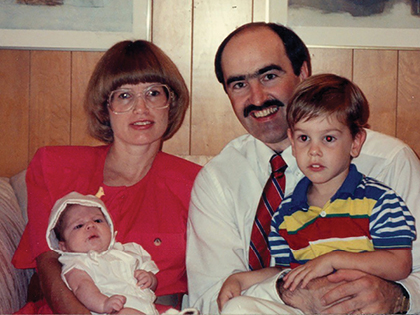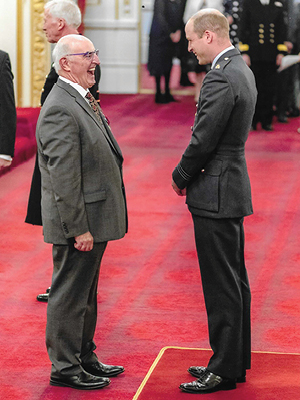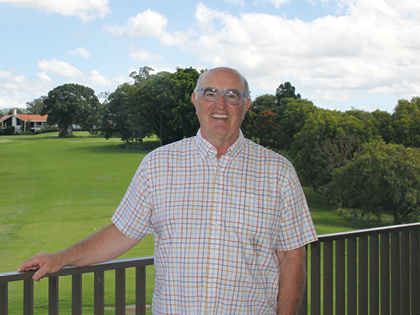Humans of Aura
Alasdair McDowall: How a lad from Edinburgh became a Nobel Prize holder
It is 3am, pitch dark and I’m on the balcony of my Somerset Indooroopilly apartment in Brisbane on a Zoom call with colleagues in California. We are discussing the latest results from experiments investigating an infectious bacterium.
These colleagues are discovering the most remarkable insights to molecular machines at atomic detail as a result of a unique experiment I carried out 40 years earlier as a young scientist in what was West Germany. In 2017, the technique was to earn the prestigious Alfred Nobel Prize for Chemistry. I still wonder how a young kid from Edinburgh became the custodian of that famous gold gong I affectionately call “Alfred’’ (below left).
My parents were a post-war Edinburgh couple and, like many at the time, were not wealthy but had simple beginnings and sensible dreams. My brother Graeme and I had a good start to life with Edinburgh blessed with an excellent history and culture for education. Dad worked hard so we both would benefit. His work often took him and my mother around the Pacific region where they were to eventually retire and are now at rest near Hobart.


At 18, I left school with a fistful of certificates but no idea what to do. So, with my parents’ blessing I headed off to Canada where I was supposed to “find myself” or at least find a job. I managed to do both but soon realised that a Banff Springs hotel summer job needed more college training to make a proper career in hospitality. I returned to Edinburgh in late 1971 just as my parents were about to leave on a two-month global tour. Their parting words to me were “report tomorrow for an interview at a local government agriculture research station” … I slept in!
I have come to appreciate the significant role many great mentors have played throughout my journey and how my career path has been subtly influenced by their wisdom, kindness and guidance. Professor Dick Barlow forgave my tardy indiscretion that morning and went on to introduce me to my first electron microscope. The instrument was to be my saviour for the next 50 years and the nexus for that Swedish gong.
So, I started my career in the pathology department of the veterinary research facility, Moredun Institute, where Dolly the Sheep was later cloned. I trained in an animal pathology service and studied medical sciences at university at night. A position in a pathology service at Edinburgh’s Institute for Occupational Medicine brought my career into the human clinical arena of respiratory diseases where to my amazement I graduated with a Master’s degree and Fellowship of the Institute of Biomedical Sciences. With this “mastery” I struck out in search of adventures beyond Edinburgh. As luck would have it, I landed in Heidelberg, West Germany, and a new mentor biophysicist Jacques Dubochet was to take me under his wing and boy did we fly. It was 1978.
The events of West Germany in the 1980s were a turning point for the world but for me at age 24, it was a launchpad for my career and my life journey. A post-rugby social event on the Heidelberg US NATO base was to be the start of now 37 years with my dear wife Leta, a super talented engineer from Kansas. Leta could write her own Humans of Aura story; such are her own amazing life experiences with the US Department of Defense. Leta has skied nearly every resort mountain in the US, Europe, NZ and Australia, and scuba dived many of the world’s reefs. Our first-born son Robbie arrived shortly before we left Heidelberg for Dallas, Texas, and our next chapter.


Before I left Germany I received a Doctorate from the University of Sorbonne, Paris. My thesis topic was the crux of a unique discovery when Jacques Dubochet and I reported the first vitrification of water at ambient pressures as seen in the electron microscope. The physicists at that time simply said that I froze water faster than was theoretically possible.
In the years following this landmark result, my colleagues and I at the European Molecular Biology Laboratory pioneered research in improved low temperature instrumentation and low dose observation techniques, which evolved into modern-day molecular cryo-electron microscopy and the awarding of the 2017 Nobel Prize in Chemistry.
I received the shattering Nobel Prize news in a 3am call from my mentor Dubochet in Switzerland. Later he would fly Leta and I to Stockholm, and for 10 days we were feted at concerts, museums, embassy functions, symphonies, symposia, the Nobel Prize giving ceremony and banquet.
My career continued in Dallas as a senior research associate of the Howard Hughes Medical Institute at the University of Texas and Director of the Microscopy Service Center. I was now on the academic ladder as an assistant professor. During our time in the US our small family grew with the addition of a brother for Robbie, with the arrival of Jamie in 1990.
In 1996 we took the brave leap and moved to Australia. The move to Indooroopilly brought our children into the same time zone as their grandparents and uncle who were living in Hobart. I became an associate professor/research appointment and co-directorship of the Centre for Microscopy and Microanalysis at the University of Queensland. While there I assisted in establishing the new Australian National cryoEM facility at the Institute for Molecular Bioscience on the UQ St Lucia campus.
In 2008, with our kids all grown up and following their own journeys in Australia, Leta and I returned to California. There I accepted the directorship of the Beckman Foundation microscopy resource and was to manage a cryoEM tomography lab at the prestigious California Institute of Technology, Pasadena. Back in the US we were closer to our Kansas family and friends, and where I could ride my Triumph motorcycle cruiser past vast fields of wheat and corn.


But the wow moments were not over for us, unknown to me the Chancellery at St James’s Palace in London heard of my research and Nobel exploits and I received an invitation from HRH to attend my Order of Australia investiture at Buckingham Palace in November 2019. The ceremony was conducted by the Duke of Cambridge, Prince William. Best of all was that our family from Brisbane and the UK could join us for the event.
In 2020 we were holidaying in Brisbane when we heard of the future Aura Holdings’ development, Somerset Indooroopilly. Since we had been long-time Indooroopilly residents, it took little time to decide Somerset was for us. Then Covid hit the globe and we managed to return to California where we quickly sold up and moved our worldly possessions to Wichita, Kansas.
The summer of 2021 was challenging for all but with some luck and border passes in hand, we slipped over the NSW-Queensland border mid-December and into our Somerset apartment for Christmas 2021. Now, proud grandparents, we live just a few minutes away from our little Elsie.


Our morning lake view of wildlife and up the fairway of the Indooroopilly Golf Course is breathtaking and evening drinks watching the sun go down sets the scene each day. So that brings me back full circle. My Zoom call on the balcony is over for this week and “Alfred’’ is looking down at me. A long overdue trip to Europe beckons. Our Somerset apartment will be in good hands until we return … just water my balcony plants, please.
At Aura Holdings we feel privileged to have so many residents who have had distinguished and successful careers. A very big thank you to Alasdair McDowall for sharing the story of his remarkable achievements. Alasdair and his wife Leta are residents of our Brisbane community, Somerset Indooroopilly.


